NURSING 119 (NURSING119)
Brightwood College
Page 3 out of 167 results
Sort by

-
Chapter 49: Endocrine Problems Lewis: Medical-Surgical Nursing, 10th Edition
- Exam (elaborations) • 15 pages • 2023
-
- $9.49
- + learn more
1. A 40-yr-old patient with suspected acromegaly is seen at the clinic. To assist in making the diagnosis, which question should the nurse ask? a. “Have you had a recent head injury?” b. “Do you have to wear larger shoes now?” c. “Is there a family history of acromegaly?” d. “Are you experiencing tremors or anxiety?” ANS: B Acromegaly causes an enlargement of the hands and feet. Head injury and family history are not risk factors for acromegaly. Tremors and anxiety are no...

-
Chapter 32: Hypertension Lewis: Medical-Surgical Nursing, 10th Edition
- Exam (elaborations) • 9 pages • 2023
-
- $8.49
- + learn more
1. Which action will the nurse in the hypertension clinic take to obtain an accurate baseline blood pressure (BP) for a new patient? a. Deflate the BP cuff at a rate of 5 to 10 mm Hg per second. b. Have the patient sit in a chair with the feet flat on the floor. c. Assist the patient to the supine position for BP measurements. d. Obtain two BP readings in the dominant arm and average the results. ANS: B The patient should be seated with the feet flat on the floor. The BP is obtained in bo...
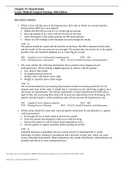
-
Chapter 32: Hypertension Lewis: Medical-Surgical Nursing, 10th Edition Complete 2023 Quiz_ Answered.
- Exam (elaborations) • 9 pages • 2023
-
- $10.49
- + learn more
1. Which action will the nurse in the hypertension clinic take to obtain an accurate baseline blood pressure (BP) for a new patient? a. Deflate the BP cuff at a rate of 5 to 10 mm Hg per second. b. Have the patient sit in a chair with the feet flat on the floor. c. Assist the patient to the supine position for BP measurements. d. Obtain two BP readings in the dominant arm and average the results. ANS: B The patient should be seated with the feet flat on the floor. The BP is obtained in bo...

-
Chapter 16: Fluid, Electrolyte, and Acid-Base Imbalances Lewis: Medical-Surgical Nursing, 10th Edition Complete 2023 Quiz_ Answered.
- Exam (elaborations) • 13 pages • 2023
-
- $8.49
- + learn more
1. The nurse is caring for a patient with a massive burn injury and possible hypovolemia. Which assessment data will be of most concern to the nurse? a. Urine output is 30 mL/hr. b. Blood pressure is 90/40 mm Hg. c. Oral fluid intake is 100 mL for the past 8 hours. d. There is prolonged skin tenting over the sternum. ANS: B The blood pressure indicates that the patient may be developing hypovolemic shock as a result of intravascular fluid loss because of the burn injury. This finding wil...
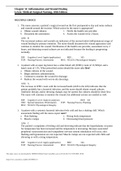
-
Chapter 11: Inflammation and Wound Healing Lewis: Medical-Surgical Nursing, 10th Edition
- Exam (elaborations) • 7 pages • 2023
-
- $10.49
- + learn more
1. The nurse assesses a patient’s surgical wound on the first postoperative day and notes redness and warmth around the incision. Which action by the nurse is appropriate? a. Obtain wound cultures. c. Notify the health care provider. b. Document the assessment. d. Assess the wound every 2 hours. ANS: B The incisional redness and warmth are indicators of the normal initial (inflammatory) stage of wound healing by primary intention. The nurse should document the wound appearance and conti...
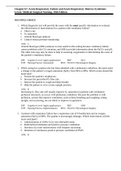
-
Chapter 67: Acute Respiratory Failure and Acute Respiratory Distress Syndrome Lewis: Medical-Surgical Nursing, 10th Edition Complete 2023 Quiz_ Answered.
- Exam (elaborations) • 10 pages • 2023
-
- $9.49
- + learn more
1. Which diagnostic test will provide the nurse with the most specific information to evaluate the effectiveness of interventions for a patient with ventilatory failure? a. Chest x-ray b. O2 saturation c. Arterial blood gas analysis d. Central venous pressure monitoring ANS: C Arterial blood gas (ABG) analysis is most useful in this setting because ventilatory failure causes problems with CO2 retention, and ABGs provide information about the PaCO2 and pH. The other tests may also be don...
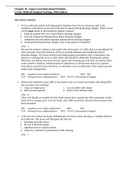
-
Chapter 41: Upper Gastrointestinal Problems Lewis: Medical-Surgical Nursing, 10th EditiComplete 2023 Quiz_ Answered.on
- Exam (elaborations) • 15 pages • 2023
-
- $10.49
- + learn more
1. A 53-yr-old male patient with deep partial-thickness burns from a chemical spill in the workplace experiences severe pain followed by nausea during dressing changes. Which action will be most useful in decreasing the patient’s nausea? a. Keep the patient NPO for 2 hours before dressing changes. b. Give the ordered prochlorperazine before dressing changes. c. Administer the prescribed morphine sulfate before dressing changes. d. Avoid performing dressing changes close to the patient’...
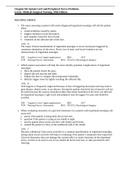
-
Chapter 60: Spinal Cord and Peripheral Nerve Problems Lewis: Medical-Surgical Nursing, 10th Edition
- Exam (elaborations) • 12 pages • 2023
-
- $9.49
- + learn more
1. The nurse assessing a patient with newly diagnosed trigeminal neuralgia will ask the patient about a. visual problems caused by ptosis. b. triggers leading to facial discomfort. c. poor appetite caused by loss of taste. d. weakness on the affected side of the face. ANS: B The major clinical manifestation of trigeminal neuralgia is severe facial pain triggered by cutaneous stimulation of the nerve. Ptosis, loss of taste, and facial weakness are not characteristics of trigeminal neural...

-
Chapter 26: Upper Respiratory Problems Lewis: Medical-Surgical Nursing, 10th Edition
- Exam (elaborations) • 10 pages • 2023
-
- $10.49
- + learn more
1. The nurse teaches a patient about discharge instructions after a rhinoplasty. Which statement, if made by the patient, indicates that the teaching was successful? a. “My nose will look normal after 24 to 48 hours.” b. “I can take 800 mg ibuprofen every 6 hours for pain.” c. “I will remove and reapply the nasal packing every day.” d. “I will elevate my head for 48 hours to minimize swelling.” ANS: D Maintaining the head in an elevated position will decrease the amount of...
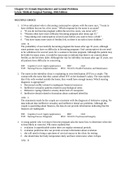
-
Chapter 53: Female Reproductive and Genital Problems Lewis: Medical-Surgical Nursing, 10th Edition
- Exam (elaborations) • 16 pages • 2023
-
- $9.49
- + learn more
1. A 34-yr-old patient who is discussing contraceptive options with the nurse says, “I want to have children but not for a few years.” Which response by the nurse is accurate? a. “If you do not become pregnant within the next few years, you never will.” b. “Women often have more difficulty becoming pregnant after about age 35.” c. “Stop taking oral contraceptives several years before you want to have a child.” d. “You have many more years of fertility left, so there is no ...

How much did you already spend on Stuvia? Imagine there are plenty more of you out there paying for study notes, but this time YOU are the seller. Ka-ching! Discover all about earning on Stuvia


